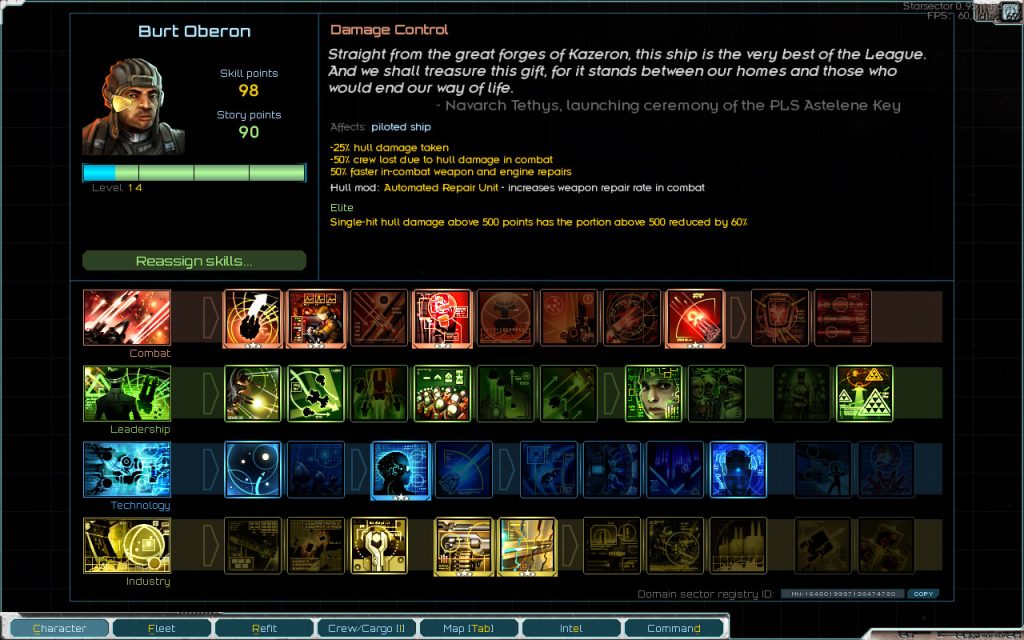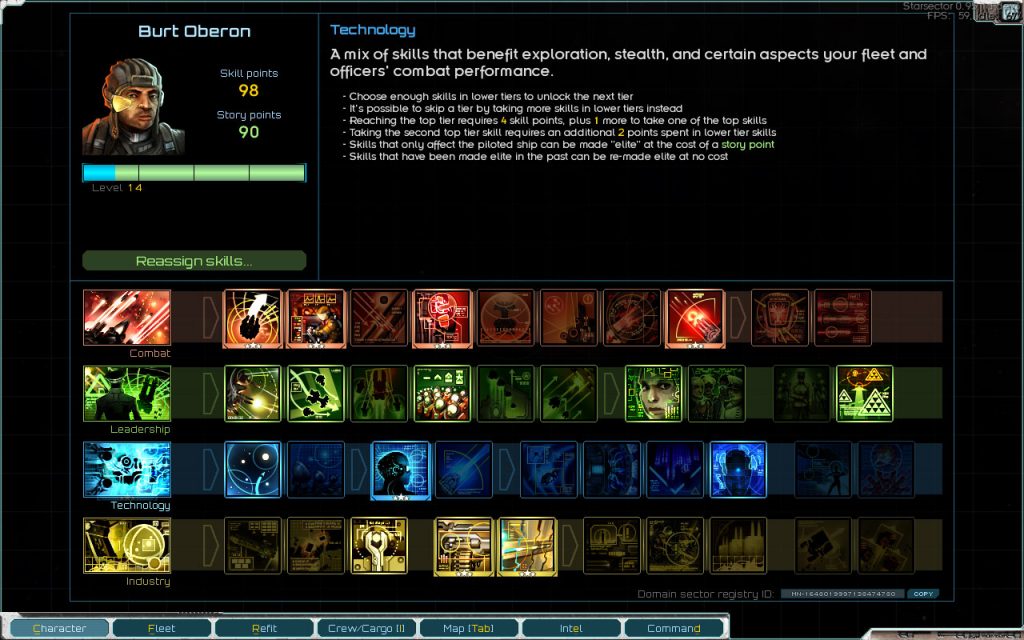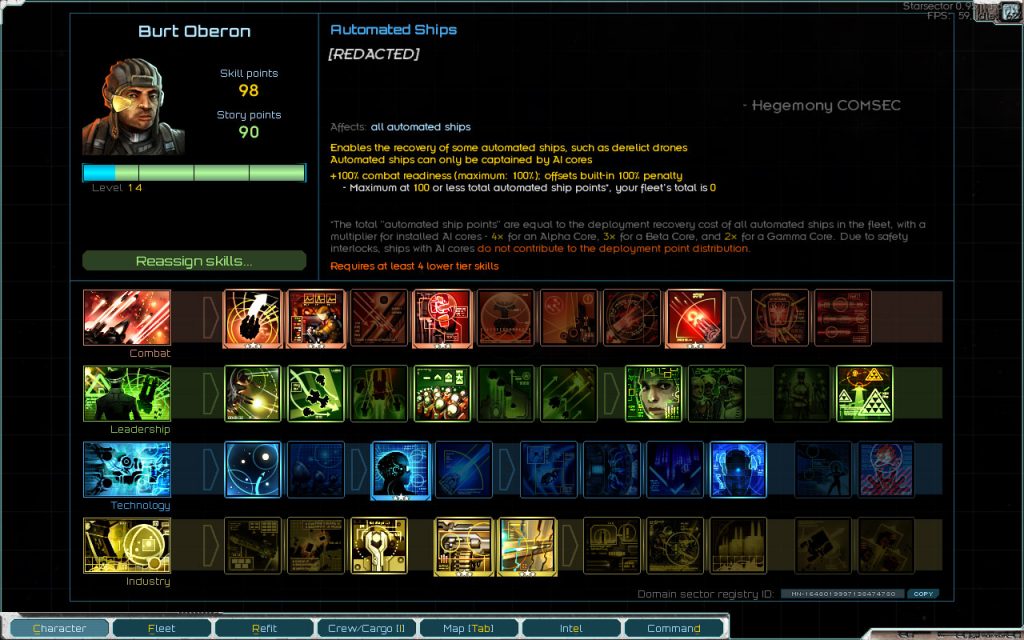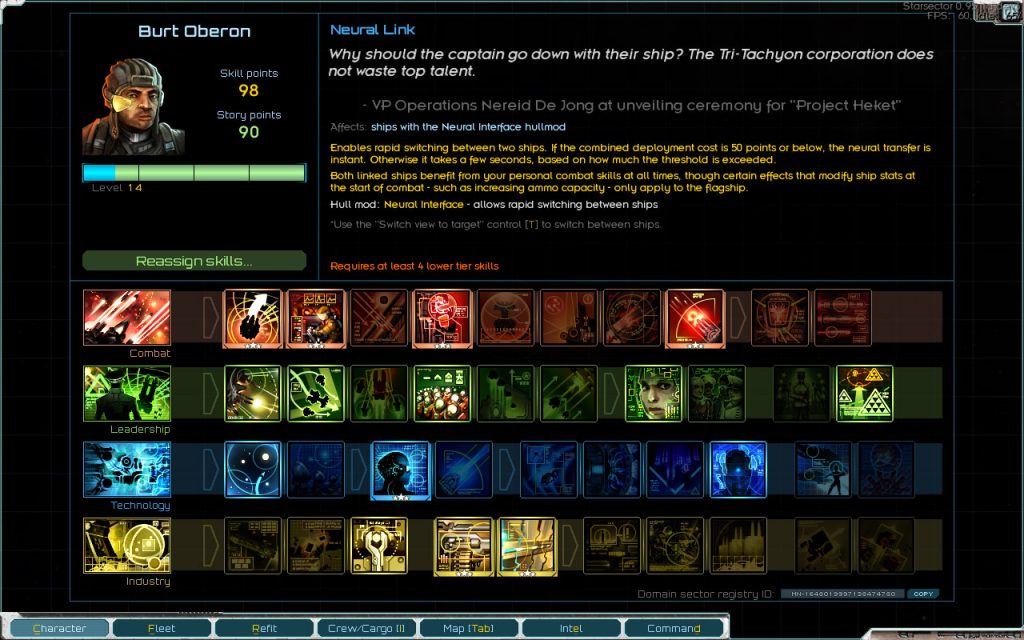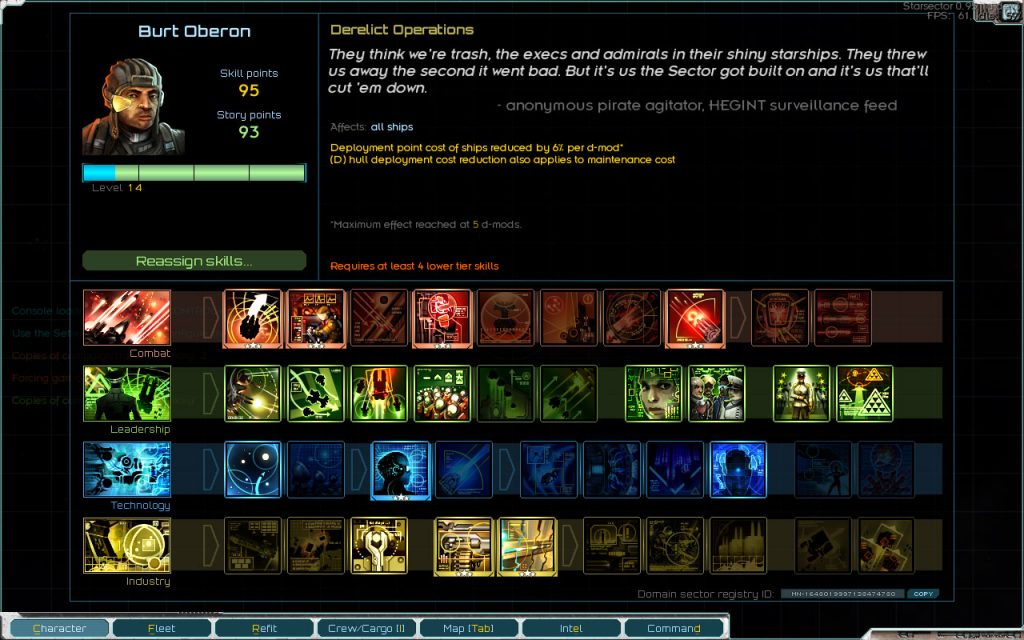Skill Changes, Part 1
The skill system – the one in the currently released version, 0.95a – has some things about it that I like, and some things that I don’t think worked out particularly well. One feature is in both categories – “pick one of two skills at every tier”. In some cases, it works well and you have an interesting choice to make. In other cases, the skills don’t lend themselves as well to it, and it ends up feeling unnecessarily restrictive.
The other high-level feature of the system that I really like is the ability to have some top-tier skills that you need to invest into an aptitude to get, and that can be powerful and game-changing. You can’t have that in a system where you can cherry-pick any skill you want at any time.
So, the goal of these adjustments is to keep the progression and high-impact choices, and add more freedom where “pick one of two” doesn’t have a compelling reason behind it.
New system
First let’s talk about how the new system is set up; then we’ll get into the details about all the changes, the new (and exciting!) skills, and so on.
Skills are still arranged in tiers, but tiers are no longer limited to two skills – instead, it’s however many skills makes sense for that specific situation. To unlock the next tier, you need to spend enough points on skills in lower tiers. How many points, exactly, also depends on the specifics – for example, if a tier has 3 skills in it, the next tier might require 1 or 2 points. The idea is to have a looser structure that can be adapted to the specific needs of the skills in that aptitude, rather than having to adapt the skills to a more rigid structure.
You can skip a tier entirely by spending those points in lower tiers instead. For example, if the first tier has 3 skills, the second tier has 2 skills, and the fourth tier requires 3 points spent total, you could just put all of them in the first tier and none in the second.
Once you get to the top tier – the skills there are high-impact, game-changing ones. You can pick one right off the bat, and this requires 4 points spent in the aptitude – 5 points total, same as now, to “max out” an aptitude. To pick up the second top-tier skill, you have to spend an additional 2 points in lower-tier skills, for a total of 8 points in the aptitude. This replaces the “wrap around after reaching the top” mechanic currently in place. This has some implications for the design of the top-tier skills, but we’ll get to that a bit later.
So, that’s the new system – now let’s dive into some specifics!
Aptitudes
Being aware of what each aptitude is about is going to be helpful for making decisions when questions come up.
“Combat” is pretty straightforward – skills that make the piloted ship perform better.
“Leadership” is about improving the combat performance of the fleet as a whole, whether through officers or by other means.
“Industry” skills focus on improving your fleet’s efficiency and resilience. This can take the form of, say, increasing salvage found or reducing supply consumption, making repairs faster and cheaper, and so on. The personal combat skills present there also have the “efficiency/resilience” themes.
“Technology” is trickier to pin down. If we’re being honest, it’s mostly “cool stuff”. A lot of the skills do touch on exploration, though, so I think a description like “a mix of skills that benefit exploration, stealth, and certain aspects of your fleet and officers’ combat performance” just about covers it – but more as a description than a particularly helpful guideline.
Top tier skills
These are the really important choices in each aptitude – taking a top tier skill boosts your power in a specific way you’ll want to take advantage of. This is less true for Combat, where the top tier skills are just generally a bit stronger. I don’t think you want “game changers” there, or you risk restricting combat to only a couple of styles based on what those hypothetical skills would enable. But for the other three aptitudes, which is what we’ll talk about in more detail, we’re looking for skills that enable different playstyles.
It only takes 8 skill points to pick up both top-tier skills from a single aptitude, but it takes 10 points to pick up one top tier skill each from two different aptitudes. This means that ideally, we want skills from different aptitudes to work together better than the top-tier skills from the same aptitude. Otherwise, it’d be too tempting to just always pick both top-tier skills in a single aptitude and have a few more points left over to spread around.
Something helping us here is that picking 6 out of the 8 lower tier skills means you’re probably picking some skills that don’t support what you want to do as well as, say, picking 4 out of 8 (to get just one of the top tier skills) would. Still, superior cross-aptitude synergy is something to strive for.
How powerful should these top-tier skills be? Since we’re talking about a varied set of skills that cater to different styles of play, balance is going to be pretty vague! But still, we need something to aim for. For that, let’s turn to two current top tier skills that compare to each other well power-wise despite having radically different effects.
One is “Special Modifications”, whose primary effect is to let you build an extra “free” hullmod into your ships. The other is “Automated Ships”, which at its best lets you have an absolute monster of an AI-core-piloted ship in your fleet.
So, the balance… not even “guideline”, but let’s call it a “point of reference” is that a top tier skill should be either 1) roughly as good as an extra top-quality hullmod on your ships, or 2) as good as having an extra top-of-the-line ship in your fleet.
With that in mind, let’s look at the new top-tier skills for Leadership, Technology, and Industry.
Best of the Best
The first top-tier Leadership skill, this has two effects. The main one is that it lets you build an extra “free” hullmod in, exactly like Special Modifications (gone to make room for something cool, press F) does now. The second effect increases the starting deployment points in battle as if you had a Comm Relay under your control. In-fiction, the skill represents your ability to identify the best performers in your fleet and put them in key positions – the best engineers, the best tactical officers on your staff, and so on.
Playstyle-wise, I think this skill caters to a player that likes to feel like they have the best quality stuff they can get, and is more at ease if their fleet’s strength is more… “self-contained”, maybe is the right word? Rather than dependent on specific actions. Specifically, getting more starting deployment points without having to capture objectives I think will feel more comfortable for some players.
Support Doctrine
The second top-tier Leadership skill, this one focuses on making ships without officers more useful. The effects are two-fold: ships without officers benefit from the non-elite effects of 3 combat skills (Helmsmanship, Damage Control, and Combat Endurance), and ships without officers have their deployment points cost (not the supply cost to recover from a deployment, just the deployment points) reduced by 20%, limited to 10 points maximum per ship. (Note: deployment points are now shown on the ship tooltip as a separate stat, to help make these sorts of things clear.)
The key effect is the deployment point cost reduction – it lets you get more ships onto the battlefield at the same time! It’s not a huge number of points, but altering the relative numbers on each side makes an outsized difference.
The specific combat skills chosen are important. Damage Control reduces crew casualties, and that helps support continually deploying larger numbers of ships – and probably losing more of them, because they’re not as strong on an individual basis. Combat Endurance increases peak time – very useful for frigates in larger battles! – and, more importantly, increases the maximum combat readiness of the ship. This combines with Technology’s “Automated Ships” skill, which uses CR as a limiter on the number of automated ships you can maintain, potentially opening the door to a style of using high numbers of automated ships without installing AI cores to control them.
Helmsmanship is more just all-around useful and doesn’t benefit different kinds of ships too disproportionately, but it’s less important than the other two skills.
This skill presented a thorny design challenge – why wouldn’t the player deploy their most expensive ship (which takes less points now), and then transfer command to it? I looked at a lot of ways to get around this – different rules for how the point reduction is calculated, or just straight up always applying the reduction to the player’s flagship – but all of them had problems and incentivized other weird kinds of behaviors.
In the end, I think what’ll work best is to just accept that this is something that the player can do, but to lean into it and have the skill acknowledge it. To that end, the skill also grants +100% command point regeneration if you haven’t transferred command to a ship that didn’t have an officer – and the deployment point reduction only applies after your command-transfer shuttle has finished landing at the destination ship, so e.g. briefly taking off, deploying more stuff, and landing, will not work – you’d have to wait out the full duration of the transfer.
So: a limited benefit to doing it, and a bit of a benefit to not doing it. Plus, importantly, an explicit acknowledgement that you can do it, which’ll make it feel like less of an exploit.
Automated Ships
An existing Technology skill, it’s not fundamentally changed from the version that’s currently in the game, though there are significant adjustments to the numbers involved.
For a quick overview, it lets you have some automated droneships in your fleet, that you otherwise only encounter as enemies in the campaign. The number of automated ships is limited – the more you have, the lower their combat readiness, representing that the limited expertise in their maintenance etc is being stretched thin.
Automated ships can be boosted by installing AI cores to control them. In the current version, each AI core has a flat cost – that is, installing one on a frigate or a battleship has the same impact on the difficulty of maintenance. This is now changed to a multiplier – Alpha, Beta, and Gamma core multiply the “points” value of the ship by 4x, 3x, and 2x, respectively.
What this does make lower-cost ships more viable, so that for example Domain Derelicts – a lower-tier class of enemy you encounter – could still be worth using in your fleet, kitted out with Alpha Cores. Now, you’re generally better off putting AI cores on more expensive ships to get more out of the skill.
(A bit specific, but: as another consequence of this change, AI cores in automated ships in human fleets no longer count as “officers” for the deployment points calculation. Otherwise, with how the math works out, you’d want to have like 20 of the cheapest ships stuffed with AI cores just to game that calculation and that’d be… bad. In-fiction: safety interlocks limit AI core access to tactical information and command protocols etc etc etc.)
The “gold standard” for this skill is still “Radiant-class battleship with an Alpha Core, with combat readiness just above malfunction levels”. There’s a nice synergy with “Support Doctrine”, though – core-less ships would have higher CR (and so you could have more of them), and cost less points to deploy, so you can have more of them on the field. And of course further boosting that Radiant via “Best of the Best” is a solid choice, too.
Neural Link
A new top-tier Technology skill. This lets you rapidly switch between two (and only two, at a time) ships with the “Neural Interface” hullmod. The other ship can’t have an officer assigned to it. The key part of this skill is that when deployed in combat, both ships benefit from your personal combat skills at all times, not just when you’re in direct control.
Switching between ships is accomplished by using the “switch view to target” control, ‘T’ by default. If the combined deployment points of the two ships are 50 or less, the transfer is instant, otherwise it takes a few seconds depending on by how much the threshold is exceeded.
This obviously synergizes very well with taking a bunch of Combat skills, so that both ships are great – it’s a multiplier on the return you get for Combat skills. I also had to make a decision about whether the Neural Interface hullmod would be able to be installed on automated ship, finally letting you pilot these yourself. On the one hand, this goes against the general idea of not having top-tier skills in the same aptitude work too well together. On the other hand, it’s just too cool not to do, so that won out.
I expect ace pilots could do some ridiculous things with this skill – but a more tame approach of just boosting a pair of capital ships to otherwise-unattainable levels with personal combat skills could do quite well, too. I could also see linking, say, a pair of cruisers on different sides of the battlefield, and using the link to apply your personal influence on the battle with pinpoint precision.
Hull Restoration
A new top-tier Industry skill. In keeping with the theme of Industry, it’s a skill about resilience – specifically, taking much of the sting out of ship losses.
A quick aside on ship recovery! Currently, ships that have been destroyed in battle are (almost) always recoverable if they have the Reinforced Bulkheads hullmod, or if they have an officer with specific skills, or if you have a specific fleetwide skill that affects ships with officers. I’ve simplified this to “Reinforced Bulkheads, an officer, or any s-mods built into the hull”. (“S-mods” are permanent and free beneficial hullmods built into a hull using story points.)
The effect is to remove needless “makes ships with officers always recoverable” effects from a number of skills. For this skill, though – one of its effects is to make all ships, not just ones with officers, “always recoverable”.
(And, another aside: “d-mods” are “permanent damage” debuffs that ships can suffer from either due to manufacturing defects, or from being disabled in battle and subsequently recovered.)
The skill has two main effects. One is that ships have a 75% (for larger ships) to 90% (for smaller ships) chance to avoid d-mods if they are lost in combat. The other is that every month, it’s very likely a d-mod will be repaired from a randomly selected hull. In addition, there’s a high chance to remove a single d-mod from a newly-acquired hull.
Taken together, these effects mean that if ship losses are kept within reason, you can keep a pristine – that is, without d-mods – fleet going. And, you can recover a rustbucket and turn it around given a bit of time. There’s still the sting of spending more supplies to repair up a ship that was lost and then recovered, but another Industry skill – Field Repairs – helps that along by making it both cheaper and faster.
Another effect of this skill is an increased maximum combat readiness for ships with s-mods. It makes sense for the skill, and has some nice synergy with both “Best of the Best” and in particular with “Automated Ships”. Generally, though, this skill will synergize well with just about anything (not caring much about losses is good), except for –
Derelict Operations
The second top-tier Industry skill, this one is about making junkfleets – fleets made up of ships with lots of d-mods – work.
The primary effect is to reduce the deployment points cost of ships with d-mods based on the number of d-mods they have. So, yeah, it’s junk – but now you have more of it on the field. Previous iterations of this type of skill tried to make junk ships better, for example by reducing the penalties from d-mods. I think this new approach is fundamentally better – rather than reducing the differences and making junk ships more like regular ships, it’s instead keeping that difference, while taking advantage of it to do something that’ll make junk fleets feel different to use.
The skill also reduces the maintenance cost of ships with d-mods. This is further helped along by other industry skills, which reduce supply and fuel use and cheapen and speed up repairs – all potential issues faced by a large fleet of low-quality ships.
Perhaps obviously, this skill really doesn’t mix well with the other top-tier Industry option, Hull Restoration – to the point where mixing them is actually a bit of a negative. But with this system and design goals, that’s all to the good.
It does mix well with other top-tier skills – you could stack deployment point reductions with Support Doctrine, for example, or have more automated ships.
This covers all of the (non-Combat) top tier skills. Next, I’d like to briefly go through the structure of each aptitude’s skills – not to dissect every last bit of it, but just to highlight anything I think is interesting.
Combat
This one’s pretty simple – the first tier has 8 skills in it, and the second tier has the 2 top-tier skills. The actual skills are pretty comparable and which ones to get is more of a style preference / tailoring them a bit to the ship you want to fly, so there’s no reason for more restrictive tiering.
Leadership
The first tier has 6 skills. The second tier and the top tier have two skills each.
The important thing here is that the second tier has the two officer skills – Officer Management and Officer Training. They synergize well, so if you could easily take both, you very likely would. But since the second tier requires 3 points to unlock, once you put another point into one of the officer skills, you’re at 4 points and can unlock a top-tier skill next. If you *also* choose to unlock the second officer skill, that’s 6 skills spent in Leadership – and given that you have 15 skill points maximum, that means you’re giving up a top-tier skill elsewhere to do this.
Of course, you might also decide to put 8 points into Leadership and grab both of its top-tier skills. That’s not necessarily a bad decision, but I think the top two skills don’t mesh particularly nicely, and there’s enough questions about alternatives being better that this doesn’t stand out as the “optimal” way to go.
A related point here is about high-level officers you can find in cryopods scattered on the fringes of the Sector. In the currently-released build, there are too many of them, which makes the Officer Training skill less worthwhile – instead of levelling up your officers, you can just (eventually) find a bunch of higher-level ones in cryopods and use them instead.
For the next release the number of these high-level officers is limited, so that there’s only a few in the entire Sector, and you can’t just fill your entire roster with them. Part of the way they work, though, is that you pay a bit of a price for their extra power by having to work with their skillset and personality. Now that there are fewer of them and there’s less opportunity to pick ones that you can make work, there’s a “retrain” option that lets you make some limited adjustments to skills (namely, change which ones are elite) and personality.
Technology
Here, we’ve got a 2-2-4-2 structure. The first two skills are Navigation and Sensors, both more quality-of-life campaign skills. If you could skip them entirely, you’d probably feel like you had to in order to spend the points on skills that provide more concrete benefits. So, they’re both in the first tier, so you can pick one without feeling like you could’ve spent that point on something else – you couldn’t have, not if you wanted to go deeper into Technology.
The second tier has the pair of personal combat skills in Technology, separated out for much the same reason. After that, it’s a bunch of fleet-wide skills that you can pick in any combination, and then it’s on to the top-tier.
Industry
This one has a 3-2-3-2 structure. The first tier has some campaign skills, the second tier is Industry’s personal combat skills, and the third tier has some notably more powerful campaign skills. You need 1 point to unlock the second tier, and 2 points to unlock the third, so there are a lot of options available.
You could put two points in the first tier, for example, and skip the second tier entirely – or spend two points there (since the combat skills work together well and are particularly suited for low tech ships) and only spend a single point in the third tier. I rather like how the structure turned out here – it feels like it creates things to think about rather than railroading you into a restricted set of choices.
Also, importantly – the top tier skills of Industry are pretty different! One is about running a pristine fleet, and the other is about a junkfleet. This means that the aptitude has to have enough skills that are useful for either case, and it does.
This concludes part one of this two-part blog post! In part two, I’ll talk about:
- Colony skills
- Elite skill effect changes
- “Low tech” (but not really) skills
- Some of the new skills
- Phase cloak changes
- Permanent skills
- Save compatibility (spoiler: yes)
Part two of this two-part blog post is here.
Comment thread here.
Tags: AI cores, automated ships, campaign, game design, mercurial scythe of balance coming for your phase ships in part 2, skills
